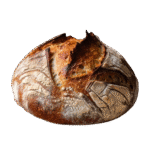Please note that this is a basic sourdough bread recipe. Sourdough baking is as much art as science, and it may take a few tries to get a feel for the process. The dough should be wet and sticky, but not so much that you can’t handle it. Adjust the amount of water as needed, based on the specific flour you’re using and the humidity in your environment. Enjoy your baking!
Simple Sourdough Bread Recipe
Equipment
- A kitchen scale.
- A glass or plastic container for your starter.
- A large mixing bowl.
- A Dutch oven or bread cloche.
- A banneton (bread proofing basket) or another bowl for shaping and proofing your bread.
- A lame or sharp knife for scoring the bread.
- A bread thermometer (optional).
Ingredients
- 50 g sourdough starter.
- 350 g lukewarm water.
- 500 g bread flour.
- 10 g salt.
Instructions
- Feed your starter 8-12 hours before you plan to make your dough.
- When the starter is bubbly and active, combine 50g of starter with 350g of lukewarm water in a large mixing bowl.
- Add 500g of bread flour, and mix until no dry flour remains.
- Let the dough rest (autolyse) for about 30 minutes.
- Add 10g of salt and mix to incorporate.
- Cover the dough and let it rise at room temperature. This will take 4-8 hours depending on the temperature and the activity of your starter.
- Every hour for the first 2-3 hours, stretch and fold the dough over onto itself to develop the gluten.
- When the dough has roughly doubled in size, turn it out onto a lightly floured surface.
- Shape the dough into a ball by pulling the edges into the center, then flip it over and use your hands to pull it towards you, creating tension on the surface.
- Place the dough seam-side up in a well-floured banneton or a bowl lined with a well-floured towel. Cover, and let it proof until it’s risen by about half again, usually 1-2 hours.
- Preheat your oven to 500F (260C) with the Dutch oven inside.
- Carefully turn the dough out onto a piece of parchment paper. Score the top with a lame or sharp knife.
- Lower the dough (on the parchment) into the hot Dutch oven. Be very careful to avoid burns.
- Bake covered for 20 minutes, then reduce the heat to 450F (230C) and bake for another 10 minutes.
- Remove the cover and continue to bake until the bread is a deep brown color and sounds hollow when tapped on the bottom, about 20-30 more minutes. Optionally, use a bread thermometer to confirm the bread is done; it should read about 210F (100C) in the center.
Notes
Cool the bread on a wire rack for at least an hour before slicing.
